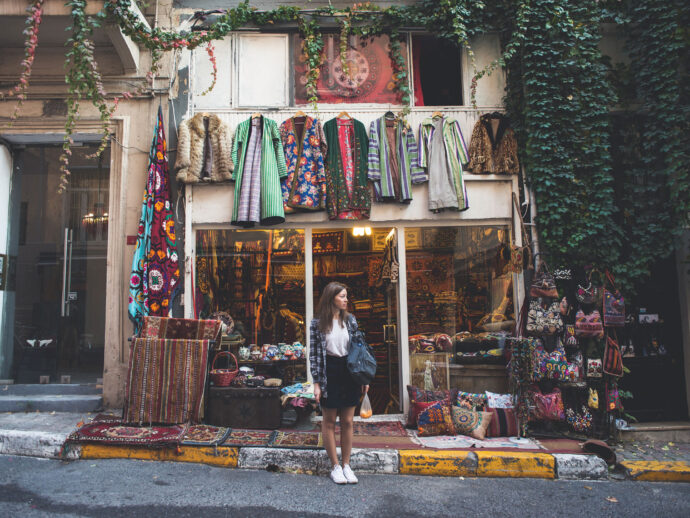
Vintage dressing is a fashion-forward trend that’s about finding something old and giving it new life.
Some of our most fashion-forward style setters are those who look back to other eras to revive long-ago closeted fashion trends. Not only is it a clever reuse of retired clothing, but it’s also a creative way to breathe new life into old couture.
Fashions of the 1950s may bring to mind poodle skirts and saddle shoes, but there was much more to it than that. Softness and femininity characterized women’s swing skirts and everyday dresses; when men weren’t wearing dark suits, they sported slacks, cardigans, and vests.
The style of the era of Elvis is one that Nicole Holway works hard to recreate. With a passion for vintage fashion and the patience to root through racks of used clothing, the Vermilion, Alberta, resident has developed a distinct personal style by making the old new again.
“I’ve always loved old clothing, and I also love history,” Holway says. “Fifties-style fashion is really about the feminine silhouette. I started dressing vintage five years ago, and that’s when I started thrifting.”
While American rap duo Macklemore and Ryan Lewis may have elevated second-hand wardrobes to super-cool status with its hit song “Thrift Shop,” vintage dressing is a fashion-forward trend that’s about finding something old and giving it new life.
Rethink your wardrobe
Whether it’s that printed skirt that’s been sitting in your closet for years or a pair of jeans you picked up at a clothing swap, you can achieve new heights of fashion by reusing and repurposing all sorts of pieces.
“I find it extremely creative to visualize something that’s been tossed aside, that’s already had a life, in a new, fresh way,” says Lauren Clark, who, along with Lyndsey Chow, runs Hey Jude, a Vancouver boutique that sells the friends’ reimagined one-of-a-kind finds. The two scour vintage shops, thrift stores, and flea markets from Vancouver all the way down to Los Angeles, bringing back distressed denims, mint-condition linens, luxurious silks, and more.
“The slow-fashion movement means to value quality over quantity,” says Melissa Ferreira, founder of Adhesif Clothing, a line made from upcycled materials. “The fibres of older textiles are often better quality. And older and antique textiles are infinitely more interesting than the likes of newer, more generic materials. There’s a heartbeat and a story to tell. I still swoon when I find something really special, like vintage silk brocade or a hand-woven tweed.”
Rethink how you shop
So, once you’re ready to recreate your own wardrobe or stock it with used items, how do you go about it? For starters, remember patience is a virtue.
“You have to approach thrifting like a treasure hunt,” Holway says. “If you go in saying, ‘I need a black skirt,’ you’re never going to find it. But if you go in and think, ‘Let’s see what I find today,’ you’re going to find pieces that will help you build up your wardrobe.”
She has the same approach to clothing swaps too, plus these fun, social gatherings offer the advantage that the garments you take home are free.
Clark agrees that you can’t have a specific item in a certain size and colour on your wish list when you source second-hand items, urging people to have an open mind. “We look for inspiration beforehand to get some ideas,” she says. “We look for shape, fit, things with a modern aesthetic to them. We touch everything to feel for good fabrics. We look for natural fibres—silks, cottons, wools, linens. They just feel better.”
Create a new look with a few nips and tucks
A practical way to get the most out of your used finds is to pick up a needle and thread. Sewing has become something of a lost art, but it’s a skill that Holway draws on frequently.
“There are a lot of things you can find that, even if you don’t like them the way they are, maybe just need to be hemmed or you just need a button changed or sleeve taken off,” she says. “Do something simple to change the look.”
Ferreira encourages people to keep trying if the process proves difficult at first. “Don’t give up,” she says. “Challenge yourself to be better than you were yesterday in every aspect of design. Find your own style and stay true to it.”
Did you know?
There’s more to vintage fashion than creating a look with personality. It’s also a way to lighten your environmental footprint. The average North American tosses out 81 lbs (37 kg) of clothing every year, according to a 2016 survey by Savers, a global thrift retailer.
Old school online
Try these websites to go vintage shopping at home.
ThredUP
The globe’s largest online venue for second-hand women’s and kids’ clothes ships to Canada and other countries. thredup.com
Rusty Zipper
This was the world’s first online vintage store. Besides clothing, it carries sewing patterns, posters, books, and more. rustyzipper.com
Etsy
Search for “vintage” and find everything from slip dresses to silk blouses. etsy.com/ca
eBay
You can shop by category or by decade, as far back as the 1910s. ebay.ca
Vintage lifestyle
There’s more to true vintage style than clothes that are more than 20 years old. It also applies to other elements, including accessories (think gloves, hats, jewellery, glasses, cuff links, ties, purses, scarves, and shoes), furniture (from commodes to sectional sofas), home décor, dishes, and music.
“Recycling is part of our everyday lives,” Lauren Chow says. “It has the potential to be daily practice, not just for what goes in the recycling bin.”



































